I am plotting data from multiple files. I do not want to use the glob module since I need to plot the data from each file separately. The data is plotting, but there are 'traceback' lines on the plot when they are graphed using Matplotlib. The image of the plots is below:
Here are some sample data to help solve the problem and im sorry about the lack of formatting. The data is from unformatted text files. If you split the two data sets into two separate files it should recreate the issue.
Start-Mi, End-Mi, IRI LWP, IRI R e
194.449, 194.549, 75.1, 92.3
194.549, 194.649, 85.2, 82.8
194.649, 194.749, 90.8, 91.8
194.749, 194.849, 79.3, 73.7
194.849, 194.949, 76.9, 80.1
194.949, 195.049, 82.7, 86.9
195.049, 195.149, 103, 116.7
195.149, 195.249, 81.5, 96.1
195.249, 195.349, 96.7, 92.7
195.349, 195.449, 59.5, 72.2
and
Start-Mi, End-Mi, IRI LWP, IRI R e
194.449, 194.549, 79.9, 95.7
194.549, 194.649, 87.4, 96.5
194.649, 194.749, 86.5, 105.3
194.749, 194.849, 77, 76
194.849, 194.949, 73.6, 85.2
194.949, 195.049, 81.7, 94.3
195.049, 195.149, 104.6, 128.2
195.149, 195.249, 84.2, 98.6
195.249, 195.349, 94.2, 91.3
195.349, 195.449, 57.5, 72.1
The traceback lines are created when the code begins a new data plot on a new file. Im trying to get rid of the horizontal lines drawn from the end of the plot back to the beginning. I need clean up the plot since the code is designed to iterate over a indefinite number of data files. The code is shown below:
def graphWriterIRIandRut():
n = 100
m = 0
startList = []
endList = []
iriRList = []
iriLList = []
fileList = []
for file in os.listdir(os.getcwd()):
fileList.append(file)
while m < len(fileList):
for col in csv.DictReader(open(fileList[m],'rU')):
startList.append(float(col['Start-Mi']))
endList.append(float(col[' End-Mi']))
iriRList.append(float(col[' IRI R e']))
iriLList.append(float(col['IRI LWP ']))
plt.subplot(2, 1, 1)
plt.grid(True)
colors = np.random.rand(n)
plt.ylabel('IRI value',fontsize=12)
plt.title('Right IRI data per mile for 2016 calibrations: ')
plt.plot(startList,iriRList,c=colors)
plt.tick_params(axis='both', which='major', labelsize=8)
plt.subplot(2, 1, 2)
plt.grid(True)
colors = np.random.rand(n)
plt.ylabel('IRI value',fontsize=12)
plt.title('Left IRI data per mile for 2016 calibrations: ')
plt.plot(startList,iriLList,c=colors)
plt.tick_params(axis='both', which='major', labelsize=8)
m = m + 1
continue
plt.show()
plt.gcf().clear()
plt.close('all')

